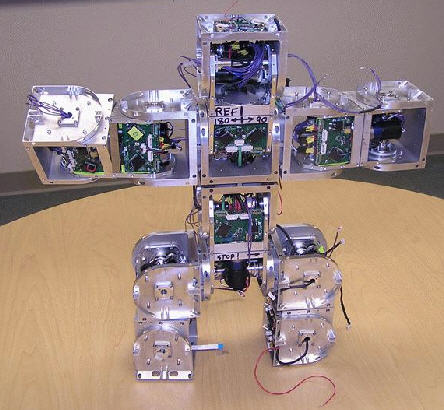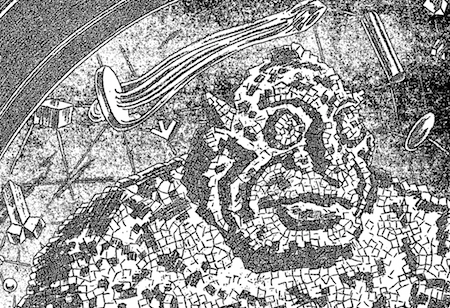Science Fiction
Dictionary
A B C D E F G H I J K L M N O P Q R S T U V W X Y Z
SuperBot Modular Robot Connects With NASA

SuperBot is a modular, multifunctional and reconfigurable robot, designed by Dr. Wei-Min
Shen and his team at the Information Sciences Institute at USC. You might say that SuperBot is
really a set of individual robots that work together to move around and solve problems. Dr. Shen
has been awarded more than $8 million in grants from NASA, DARPA and the NSF to continue his
research, including constructing a 100 module prototype to demonstrate how SuperBot might be used
in space exploration.
(SuperBot youtube video ([skip to 1 minute mark])
Dr. Shen points out the limits of the current set of robotic devices used for space exploration:
One of the most challenging issues for human-centered long-range space exploration is performing complex tasks in environments that are not human-friendly.... the traditional approach of building separate robots for separate tasks (such as the Canada Arm and surface rovers) may no longer be adequate for affordable space exploration as the required robotic tasks become diverse and the need to pack many functionalities into a single launch volume increases.
Dr. Shen proposes the SuperBot modules as a way to meet this goal. Each module is a "robot" in its own right, with microcontrollers, sensors, communications, power supply, three degrees of freedom and six connecting faces to dynamically connect with other modules. At launch, or when landing, SuperBot can pack itself into a minimum amount of space.

(SuperBot modular robot)
Upon arrival, SuperBot can unpack itself and take any of a wide variety of forms. For example, it might form several exploration rovers, one SuperBot capable of rolling down hill, another twisting "sidewinder-style" over level sand while another forms a SuperBot climbing robot to take on more challenging terrain.
(SuperBot forms 'sidewinder' snakebot)
SuperBot will help NASA to reduce costs and simplify operations by reusing robotic components from mission to mission. If the robotic modules are truly interchangeable and interoperable, the need for redundant parts on a given mission can be reduced, thus lowering payload mass and cost. Mission reliabilty and safety would be enhanced, since the modules themselves would know how to perform tasks, and would require less active direction from astronauts or ground crews.
Dr. Shen hopes to have his 100 module SuperBot operational and ready for testing in a desert environment by 2008.
The following articles provide more information about similar robots:
- Self-Replicating Modular Robots
Each ten centimeter cube is an autonomous unit with a microprocessor and a set of instructions on how to link themselves with other modules. - TETWalker: Shape-Shifting Robot Swarm
This bot is a prototype member of an autonomous nanotechnology swarm that can alter their shape to flow smoothly over rocky terrain.
Update 08-Feb-2017
Golden Age legend Jack Williamson wrote a great story titled The Infinite Enemy, published in Thrilling Wonder Stories in 1938, in which an alternate universe is found to contain a being comprised of metallic cubes.

End update.
Read more at the SuperBot press release and in this short SuperBot project abstract (pdf).
Scroll down for more stories in the same category. (Story submitted 2/25/2007)
Follow this kind of news @Technovelgy.| Email | RSS | Blog It | Stumble | del.icio.us | Digg | Reddit |
Would
you like to contribute a story tip?
It's easy:
Get the URL of the story, and the related sf author, and add
it here.
Comment/Join discussion ( 2 )
Related News Stories - (" Robotics ")
PaXini Supersensitive Robot Fingers
'My fingers are not that sensitive...' - Ray Cummings, 1931.
Artificial Skin For Robots Is Coming Right Along
'... an elastic, tinted material that had all the feel and appearance of human flesh and epidermis.' - Harl Vincent (1934)
Robot Guard Dog On Duty
I might also be thinking of K-9 from Doctor Who.
Wearable Artificial Fabric Muscles
'It is remarkable that the long leverages of their machines are in most cases actuated by a sort of sham musculature...' HG Wells, 1898.
Technovelgy (that's tech-novel-gee!) is devoted to the creative science inventions and ideas of sf authors. Look for the Invention Category that interests you, the Glossary, the Invention Timeline, or see what's New.
Science Fiction
Timeline
1600-1899
1900-1939
1940's 1950's
1960's 1970's
1980's 1990's
2000's 2010's
Current News
Boring Company Vegas Loop Like Asimov Said
'There was a wall ahead... It was riddled with holes that were the mouths of tunnels.'
Rigid Metallic Clothing From Science Fiction To You
'...support the interior human structure against Jupiterís pull.'
Is The Seattle Ultrasonics C-200 A Heinlein Vibroblade?
'It ain't a vibroblade. It's steel. Messy.'
Roborock Saros Z70 Is A Robot Vacuum With An Arm
'Anything larger than a BB shot it picked up and placed in a tray...'
A Beautiful Visualization Of Compact Food
'The German chemists have discovered how to supply the needed elements in compact, undiluted form...'
Bone-Building Drug Evenity Approved
'Compounds devised by the biochemists for the rapid building of bone...'
Secret Kill Switch Found In Yutong Buses
'The car faltered as the external command came to brake...'
Inmotion Electric Unicycle In Combat
'It is about the size and shape of a kitchen stool, gyro-stabilized...'
Grok Scores Best In Psychological Tests
'Try to find out how he ticks...'
PaXini Supersensitive Robot Fingers
'My fingers are not that sensitive...'
Congress Considers Automatic Emergency Braking, One Hundred Years Too Late
'The greatest problem of all was the elimination of the human element of braking together with its inevitable time lag.'
The Desert Ship Sailed In Imagination
'Across the ancient sea floor a dozen tall, blue-sailed Martian sand ships floated, like blue smoke.'
The Zapata Air Scooter Would Be Great In A Science Fiction Story
'Betty's slapdash style.'
Thermostabilized Wet Meat Product (NASA Prototype)
There are no orbiting Michelin stars. Yet.
Could Crystal Batteries Generate Power For Centuries?
'Power could be compressed thus into an inch-square cube of what looked like blue-white ice'
India Ponders Always-On Smartphone Location Tracking
'It is necessary... for your own protection.'
